Comparison of the Contributions of CAPLUS and MEDLINE to the Performance of SciFinder in Retrieving the Drug Literature
Head, White Memorial Chemistry Library
University of Maryland
College Park, Maryland
sbaykouc@umd.edu
Abstract
SciFinder (SF) is a platform that provides access to two large databases, the Chemical Abstracts database (CAPLUS) and MEDLINE. This article analyzes and compares the individual and combined contributions of these two databases to the performance of SF in retrieving the drug literature. Test searches in which the names of two individual drugs (lisinopril and lovastatin) and a group of drugs (SSRI antidepressants) were used as keywords retrieved document sets that were analyzed for total and annual literature output, document types, journal coverage, and language of publication. While the total literature output from CAPLUS was larger than the output from MEDLINE (which was attributed to the presence of patents), MEDLINE performed significantly better than CAPLUS in retrieving the non-patent literature. The overlap of documents between CAPLUS and MEDLINE was found to be only 20-24%, depending on the name of the drug used to perform the searches. This article analyzes the strengths and the weaknesses of CAPLUS and MEDLINE and shows how these two databases, when searched together in SF, complement each other in covering the drug literature. In addition to the extended coverage of the literature, SF provides sophisticated (but easy-to-use) refining and analytical tools not available on some other platforms.
Introduction
Retrieving literature on interdisciplinary topics often requires using several databases. MEDLINE has been the most widely used database for retrieving the biomedical literature (Bianchi 2002; Weiner 2009). Freely available through PubMed, it can also be searched through some fee-based services. A previous study demonstrated that PubMed (provided by the National Institutes of Health) when used alone does not always satisfy users' needs, especially if a comprehensive literature retrieval is essential (Suarez-Almazor et al. 2000). Other studies, which examined the strengths and weaknesses of several databases in covering the biomedical literature, found that PubMed contained fewer documents than Scopus and Web of Science (WoS) (Falagas et al. 2008). Similar results were reported in a recent article, which showed that Scopus and WoS retrieved significantly more literature on several drugs than did MEDLINE (Baykoucheva 2010).
Services that integrate two or more databases on a single platform allow searching these databases at the same time and from one entry point. A recent article reported that researchers at the University of California Santa Cruz preferred using interdisciplinary databases such as Web of Science rather than subject-specific ones like PubMed (Hightower and Caldwell 2010). Vendors of such services are competing in providing new sophisticated refining and analytical tools that significantly improve search efficiency (Oprea and Tropsha 2006; Bandyopadhyay 2010).
DiscoveryGate (DG) (from Accelrys), for example, aggregates on one platform many databases that can be searched either together or individually (Baykoucheva 2007). A search performed in DG can be expanded to external databases such as PubChem, a free property database provided by the National Institutes of Health. The same search can be expanded even further, as PubChem links the records of the chemical compounds to articles indexed in PubMed (Baykoucheva 2008). A new platform from Elsevier, SciVerse, integrates two large databases -- ScienceDirect and Scopus. A third one, Reaxys, will be added to SciVerse in the near future. The first two are literature databases, while the third one is a platform that aggregates a patent database with two large property databases, the former CrossFire databases Beilstein and Gmelin.
SciFinder (SF), from the Chemical Abstracts Service (CAS), is another platform that integrates two large databases, CAPLUS and MEDLINE (Ridley 2009; Bolek 2000). While MEDLINE mostly covers journal literature, CAPLUS also covers patents. Another database included in SF is the CAS Registry File, the largest property database available today. SF has been used extensively by researchers in the area of drug discovery (Haldeman et al. 2005), but in academia it has been used mostly by chemists. Many librarians and users have indicated that this valuable resource has not gained popularity among students and researchers in the life sciences and the biomedical field mainly because this audience is not aware that SF searches MEDLINE.
The purpose of this study was to evaluate and compare the contributions of MEDLINE and CAPLUS to the performance of SF in retrieving drug literature and to show how users involved in life sciences/biomedical research could benefit from using it. The availability of sophisticated refining and analytical tools and the option of using natural language queries in SF could be very attractive to such users. In this study the names of two individual drugs (lisinopril and lovastatin) and the name of a group of drugs, "SSRI antidepressants" (which stands for selective serotonin reuptake inhibitors), were used as keywords to perform test searches in SF. The results presented here demonstrate how CAPLUS and MEDLINE contributed to the overall performance of SF in retrieving the drug literature.
Methods
Search Strategy
SciFinder Web (SF) (Chemical Abstracts Service) was used to search CAPLUS (Chemical Abstracts Service) and MEDLINE (National Library of Medicine, National Institutes of Health), either individually or at the same time. Test searches were performed using the names of two individual drugs (lisinopril and lovastatin) and the name of a group of drugs (SSRI antidepressants) as keywords. References containing the "concept" of the terms used to perform the searches were selected for further analyses. All searches in this study were performed on October 11 and October 15, 2010. The following document sets were obtained and analyzed for lisinopril, lovastatin, and SSRI antidepressants:
- CAPLUS: Document set obtained from searching SF (searches were performed in CAPLUS and MEDLINE at the same time, which is the default setting in SF) and limiting the retrieved documents only to those found in CAPLUS, using the "Refine by database" feature.
- MEDLINE: Document set obtained from searching SF (searches were performed in CAPLUS and MEDLINE at the same time, which is the default setting in SF) and limiting the retrieved documents only to those found in MEDLINE, using the "Refine by database" feature.
- CAPLUS & MEDLINE: Document set obtained from searching SF (searches were performed in CAPLUS and MEDLINE at the same time, which is the default setting in SF). Any overlapping documents were removed using the "Remove duplicates" feature before analyzing this set further. The set thus obtained contained all documents found in CAPLUS and MEDLINE, minus any duplicated records resulting from coverage overlap between the two databases; only one copy of each document was retained in this set. The strategy and the analyses performed in this study are illustrated in figures 1-3.
Database evaluation
The document sets described above were analyzed and compared in the following aspects:
- Total number of documents retrieved
- Output of non-patent and patent literature
- Coverage overlap between CAPLUS and MEDLINE
- Annual output of journal records
- Number of journals covered
- Document types
- Top 20 journals with highest number of documents retrieved by the databases
- Distribution of documents by language of publication
Selection of drugs
The names of the drugs listed below were used as keywords to perform test searches in SF:
- Lisinopril (Prinivil) is a drug from the angiotensin-converting enzyme (ACE) inhibitor class used alone or in combination with other medications to treat high blood pressure, congestive heart failure, heart attacks and in preventing renal and retinal complications of diabetes
- Lovastatin is a cholesterol-lowering drug belonging to the group of statins
- SSRI antidepressants (also called SSRIs), selective serotonin reuptake inhibitors or serotonin-specific reuptake inhibitors, are a class of drugs that are used mainly in the treatment of depression, anxiety, and some other disorders.
Results
Figures 1-3 outline the strategy used in this study and show the output of documents in each step of the analyses. The initial searches performed in SF, when CAPLUS and MEDLINE were searched at the same time (the default setting in SF), retrieved documents found in both databases. Such searches retrieved 4,769 documents on lisinopril, 10,327 on lovastatin, and 3,363 on SSRI antidepressants. Since there is some overlap of coverage between CAPLUS and MEDLINE, the document sets for lisinopril (1,037 duplicates), lovastatin (2,045 duplicates), and SSRI antidepressants (861 duplicates) were removed.
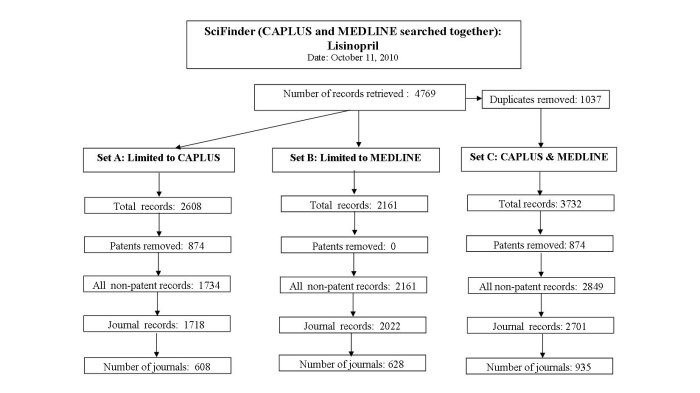
Figure 1: Strategy for retrieving literature on lisinopril and output of documents at individual steps of the process.
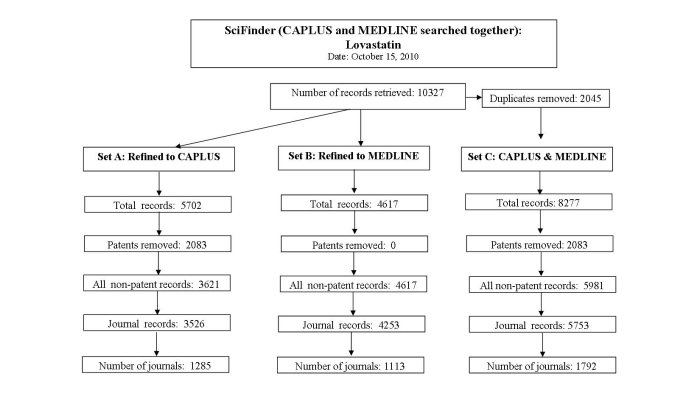
Figure 2: Strategy for retrieving literature on lovastatin and output of documents at individual steps of the process.

Figure 3: Strategy for retrieving literature on SSRI antidepressants and output of documents at individual steps of the process.
The document set obtained when lovastatin was used as a key word was processed differently than the document sets obtained when lisinopril and SSRI antidepressants were used as keywords, because the number of retrieved documents on lovastatin exceeded 10,000 -- the maximum number of documents from which duplicates can be removed in SF. In order to be able to remove the duplicates, the document set obtained for lovastatin was split into two sub-sets (using the "Refine by publication year" command) that contained documents published in two time periods: (1) 1980-2009 and (2) 2010. The subsets thus obtained were analyzed and the results obtained with them were later combined.
The results obtained for the sets of lisinopril, lovastatin, and SSRI antidepressants when SF searched CAPLUS and MEDLINE together are presented as "CAPLUS & MEDLINE." These sets contained all documents that were unique to one or the other database, as well as one copy of the documents found in both databases. The results obtained for these sets showed that the overlap of content between CAPLUS and MEDLINE was found to be from 20-26%, depending on the drug literature studied.
The documents retrieved from the initial keyword searches (when CAPLUS and MEDLINE were searched together) were refined by database, to limit the content of the sets only to documents found in the individual databases. Figure 4 compares the total literature outputs obtained from CAPLUS (document set containing documents present only in CAPLUS), MEDLINE (document set containing documents present only in MEDLINE), and CAPLUS & MEDLINE (document set containing documents retrieved when CAPLUS and MEDLINE were searched in SF together, from which all duplicates were removed).
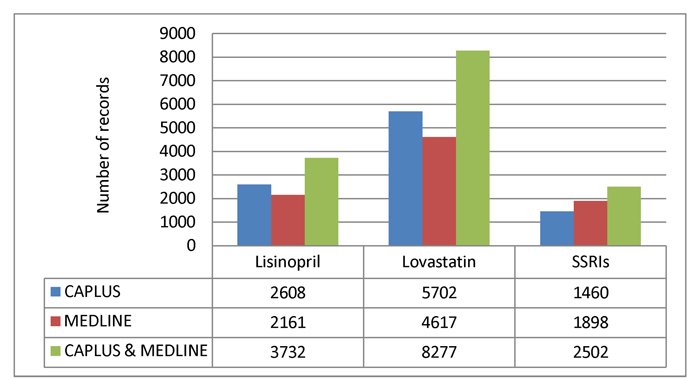
Figure 4: Total output of literature on lisinopril, lovastatin, and SSRI antidepressants retrieved from CAPLUS, MEDLINE, and CAPLUS & MEDLINE.
Tables 1-3 show the distribution of the retrieved documents by document type. In the document sets "CAPLUS" and "CAPLUS & MEDLINE" there were 874, 2,083, and 44 patents on lisinopril, lovastatin, and SSRI antidepressants, respectively. These patents were removed to obtain document sets that contained only non-patent literature.

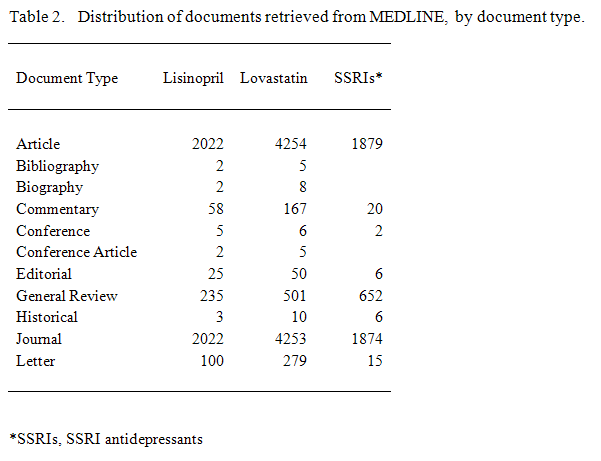
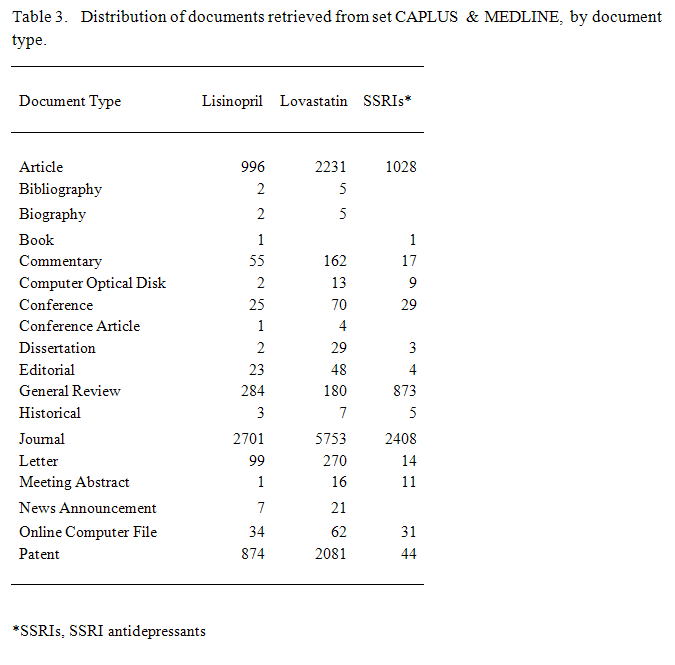
Figure 5 shows the output of the non-patent literature retrieved from the databases.

Figure 5: Output of non-patent literature on lisinopril, lovastatin, and SSRI antidepressants retrieved from CAPLUS, MEDLINE, and CAPLUS & MEDLINE.
The sets containing non-patent records were further refined by document type to limit them to journal records, which were further analyzed by publication year. The annual output of journal records was determined for each year throughout the whole publication history of the drugs, until October 11 or October 15, 2010, when the searches were performed. The first documents on lisinopril, lovastatin, and the SSRI antidepressants retrieved from the databases were published in 1981, 1976, and 1991, respectively. Figures 6-8 illustrate the annual output of documents from the databases during a 10-year period of time -- from 2000 to 2009 (the year 2009 was the last complete year of this study).
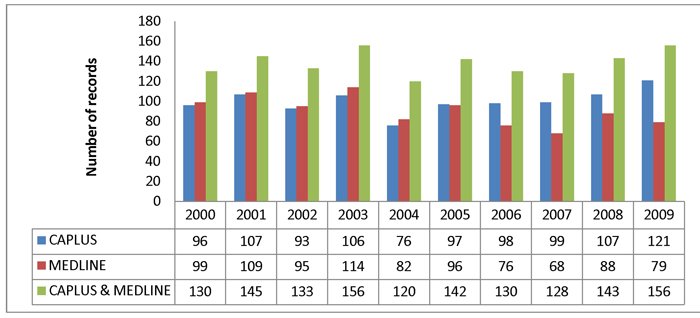
Figure 6: Annual output of journal articles on lisinopril retrieved from CAPLUS, MEDLINE, and CAPLUS & MEDLINE (2000-2009).
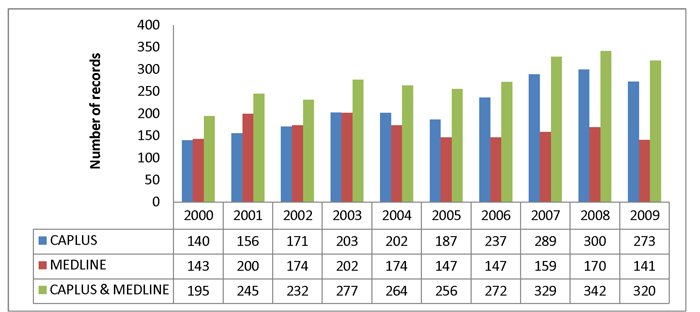
Figure 7: Annual output of journal articles on lovastatin retrieved from CAPLUS, MEDLINE, and CAPLUS & MEDLINE (2000-2009).
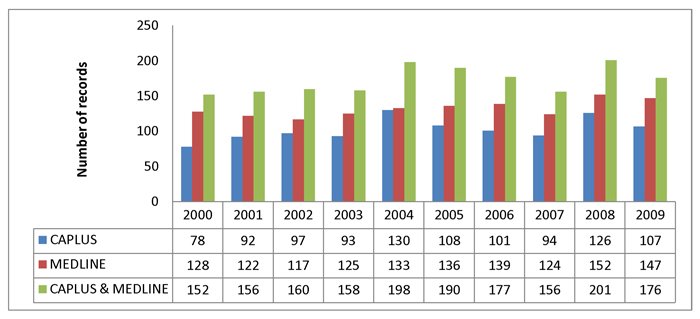
Figure 8: Annual output of journal articles on SSRI antidepressants retrieved from CAPLUS, MEDLINE, and CAPLUS & MEDLINE (2000-2009).
Figure 9 shows the number of journals covered by each database.
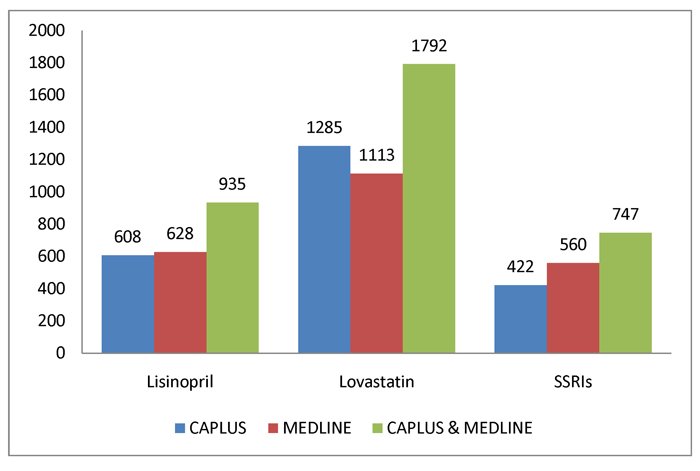
Figure 9: Number of journals containing documents on lisinopril, lovastatin, and SSRI antidepressants that were covered by CAPLUS, MEDLINE, and CAPLUS & MEDLINE.
Additional evaluation of the journal coverage was performed by comparing the lists of the top 20 journal titles from which the databases contained the highest number of articles (Tables 4-6).
Table 4. The top 20 journals with the highest number of records on lisinopril found in CAPLUS and MEDLINE (journal titles in boldface are shared by both databases).
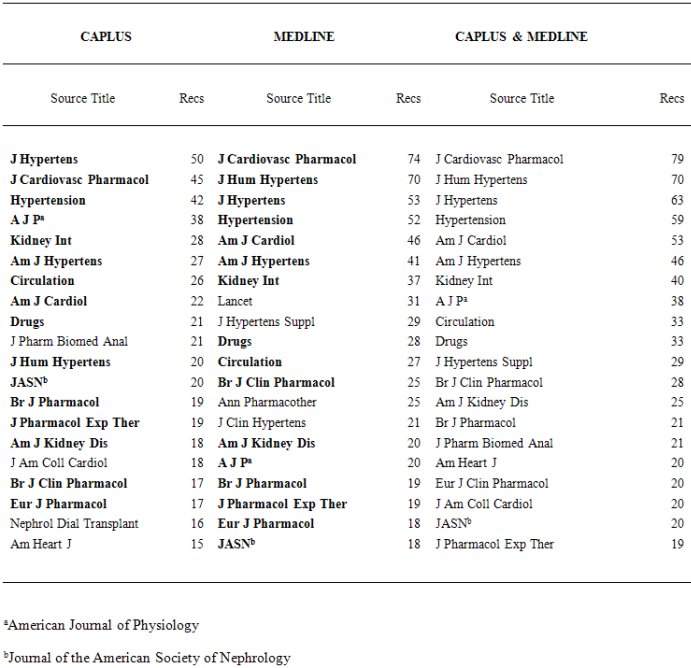
Table 5. The top 20 journals with the highest number of records on lovastatin found in CAPLUS and MEDLINE (journal titles in boldface are shared by both databases).
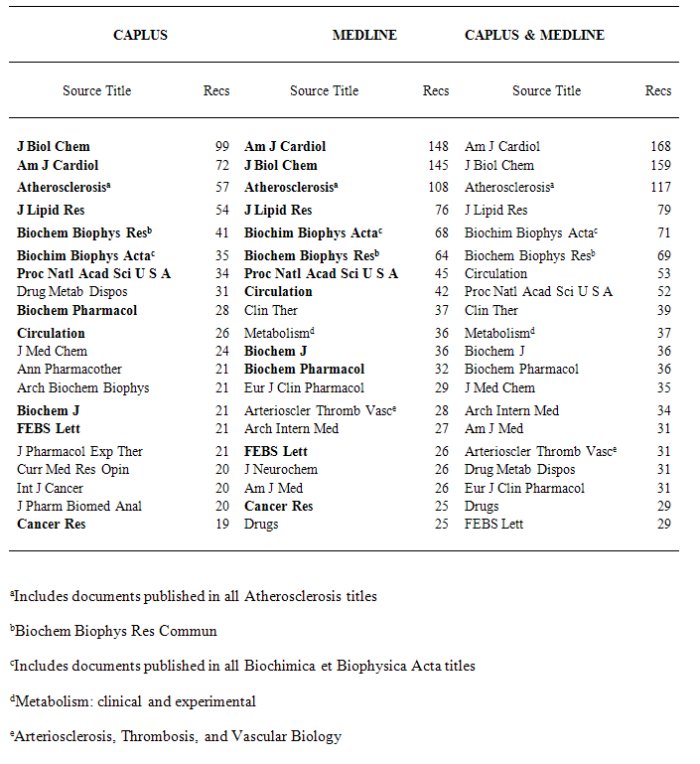
Table 6. The top 20 journals with the highest number of records on SSRI antidepressants found in CAPLUS and MEDLINE (journal titles in boldface are shared by both databases).
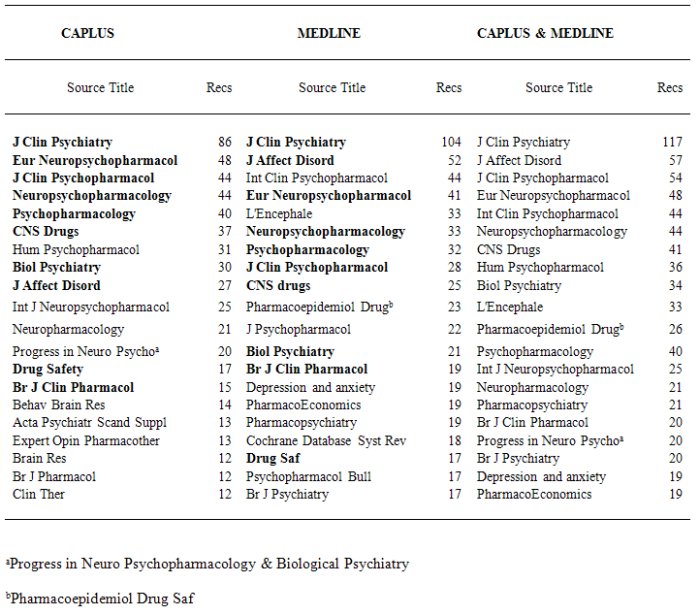
The non-patent documents retrieved from the databases were also analyzed by language of publication (Figure 10). The top five languages covered by each database are shown in Table 7.

Figure 10: Number of non-patent documents published in languages other than English retrieved from CAPLUS, MEDLINE, and CAPLUS & MEDLINE.
Table 7. Number of records published in non-English languages and found in CAPLUS and MEDLINE searched individually or together in SciFinder.
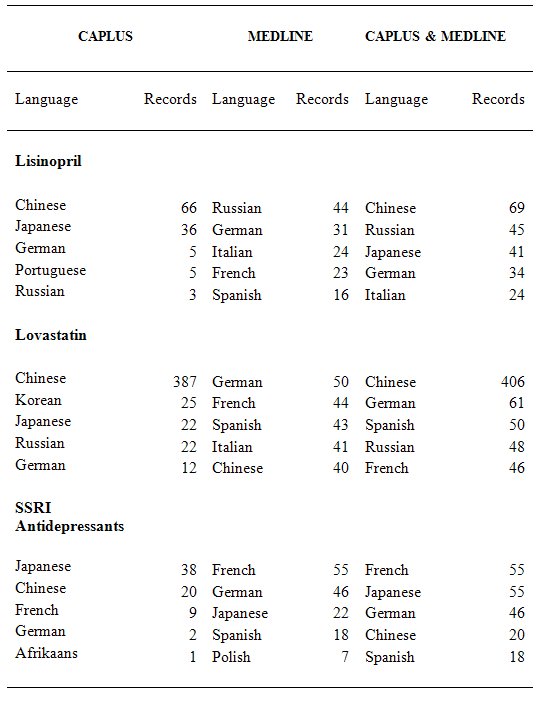
Discussion
The selection of lisinopril, lovastatin, and SSRI antidepressants as models in this study was based on the fact that these drugs significantly differed in properties and that they had long clinical and publication histories. Although CAS and MEDLINE have different indexing approaches, CAS performs systematic indexing for SF, which allows precision searches to be accomplished even when only one of the possible terms is used to perform the searches (Ridley 2009). The option of retrieving references that include "the concept" of the search term has to be selected to benefit from this strategy.
CAPLUS and MEDLINE covered almost the same publication periods for the drugs included in this study, but the peak years in which these databases had the highest number of articles on a particular drug occurred at different times. While for CAPLUS the peak of articles on lisinopril occurred in 2009, the peak for the literature on this drug happened for MEDLINE six years earlier and coincided with the peak observed for CAPLUS & MEDLINE (figure 6). The peak of articles on lovastatin for CAPLUS, MEDLINE, and CAPLUS & MEDLINE occurred in 2008, 2003, and 2008, respectively (figure 7). As shown in figure 8, the year for which CAPLUS, MEDLINE, and CAPLUS & MEDLINE contained the highest number of documents on SSRI antidepressants was 2004, 2008, and 2008, respectively. Another study, which compared results from searches performed in CAPLUS and MEDLINE, also showed that the peak years for articles happened for these two databases in different years (Brown 2003).
As shown in tables 1-3, there were more document types in MEDLINE than in CAPLUS. The document types in CAPLUS & MEDLINE were a combination of the document types of these two databases. CAPLUS contained patents, a document type not covered by MEDLINE, but the latter outperformed CAPLUS in the number of non-patent documents. Analysis of the annual journal literature output showed that MEDLINE consistently retrieved more journal articles than CAPLUS until 2004 (for lisinopril) (figure 6) and until 2002 (for lovastatin) (figure 7), but this trend changed in the more recent years, when CAPLUS started retrieving more documents on these drugs than MEDLINE. Throughout the whole history of publication on the SSRI antidepressants, MEDLINE retrieved more journal articles than CAPLUS (figure 8).
Evaluation of the retrieved documents by journal title showed significant differences in the number of journals covered by the databases. Figure 9 shows that, while CAPLUS and MEDLINE covered almost equal number of journals on lisinopril, CAPLUS covered 172 more journals than MEDLINE on lovastatin, and MEDLINE covered 138 more journals than CAPLUS on SSRI antidepressants. When the two databases were searched together (CAPLUS & MEDLINE), the number of journals covered was significantly higher than the number of journals covered by the individual databases.
Additional evaluation of the journal coverage consisted in analyzing and comparing the lists of the top 20 journal titles from which the databases have retrieved the highest number of articles. The results from these analyses showed that the lists of CAPLUS and MEDLINE shared 16, 12, and 10 journal titles that have published articles on lisinopril, lovastatin, and SSRI antidepressants, respectively (tables 4-6). The data presented in these tables also show that the number of articles from the same journals differed significantly between the databases. For example, from all shared journals MEDLINE had more documents on lisinopril and lovastatin than CAPLUS. From the 10 shared journal titles that had articles on SSRI antidepressants, CAPLUS had more documents from six and MEDLINE from four of these journals. The number of articles from the shared journals was significantly increased when the two databases were searched together (data presented as CAPLUS & MEDLINE).
Analysis of the documents by language of publication showed significant differences between the databases. While MEDLINE contained more non-patent documents on lisinopril and SSRI antidepressants in languages other than English, CAPLUS covered more such documents than MEDLINE on lovastatin (figure 10). Chinese and Japanese were the predominant languages for non-patent literature found in CAPLUS, while MEDLINE covered more documents in some of the European languages (table 7). When the databases were searched together, the output of documents in languages other than English was significantly higher than the output from the individual databases.
The total number of documents retrieved from SF was much larger when CAPLUS and MEDLINE were searched together than when they were searched separately. The original content found in the individual databases was 70-76%, depending on the drug literature. Previous studies have shown that, while the biomedical literature retrieved with PubMed significantly overlapped in content with the literature retrieved with Google Scholar (Anders and Evans 2010; Shultz 2007), CAPLUS covered a large volume of literature that was unique and could not be retrieved with Google Scholar (Levine-Clark and Kraus 2007).
Conclusions
MEDLINE is the most widely used database for retrieving the biomedical literature, but drug research is an interdisciplinary area that also requires monitoring of the chemical literature. The results reported in this article indicate that searching CAPLUS and MEDLINE together through SF significantly expands the capabilities of these two databases in retrieving literature on such interdisciplinary topic as drugs. For those who want to retrieve drug literature, using SF is a much better option than searching CAPLUS or MEDLINE alone, as these two databases complement very well each other with respect to journal coverage, document types, and languages in which the documents are published.
References
Anders, M.E. and Evans, D.P. 2010. Comparison of PubMed and Google Scholar literature searches. Respiratory Care 55(5):578-83.
Bandyopadhyay, Aditi. 2010. Examining Biological Abstracts on two platforms: what do end users need to know? Science & Technology Libraries 29(1):34-52.
Baykoucheva, Svetla. 2007. A new era in chemical information: PubChem, DiscoveryGate, and Chemistry Central. Online 31(5):16-20.
Baykoucheva, Svetla. 2008. Finding drug information in integrated chemistry and life sciences databases: PubChem and DiscoveryGate. Abstracts of Papers, 236th ACS National Meeting, Philadelphia, PA, United States, August 17-21, 2008: CINF-041.
Baykoucheva, Svetla. 2010. Selecting a database for drug literature retrieval: a comparison of MEDLINE, Scopus, and Web of Science. Science & Technology Libraries 29:276-288.
Bianchi, Stephanie. 2002. PubMed: for more than medicine this is one of the world's greatest databases. Issues in Science & Technology Librarianship 34 (Spring). [Internet]. [Cited July 11, 2011]. Available from: http://www.istl.org/02-spring/databases3.html
Bolek, Ann D. 2000. SciFinder Scholar. Issues in Science & Technology Librarianship 28 (Fall). [Internet]. [Cited July 11, 2011]. Available from http://www.istl.org/00-fall/databases.html.
Brown, Cecelia. 2003. The changing face of scientific discourse: analysis of genomic and proteomic database usage and acceptance. Journal of the American Society for Information Science & Technology 54(10):926-938.
Falagas, M.E., Pitsouni, E.I., Malietzis, G.A., and Pappas, G. 2008. Comparison of PubMed, Scopus, Web of Science, and Google Scholar: strengths and weaknesses. Faseb Journal 22(2):338-342.
Haldeman, Margaret, Vieira, Barbara, Winer, Fred, and Knutsen, Lars J.S. 2005. Exploration tools for drug discovery and beyond: applying SciFinder to interdisciplinary research. Current Drug Discovery Technologies 2(2):69-74.
Hightower, Christy and Caldwell, Christy. 2010. Shifting sands: science researchers on Google Scholar, Web of Science, and PubMed, with implications for library collections budgets. Issues in Science and Technology Librarianship. [Internet]. [Cited July 11, 2011]. Available from: http://www.istl.org/10-fall/refereed3.html
Levine-Clark, Michael, and Kraus, Joseph. 2007. Finding chemistry information using Google Scholar: a comparison with Chemical Abstracts Service. Science & Technology Libraries 27(4):3-17.
Oprea, Tudor I. and Tropsha, Alexander. 2006. Target, chemical and bioactivity databases - integration is key. Drug Discovery Today: Technologies 3 (4):357-365.
Ridley, Damon D. 2009. Information Retrieval: SciFinder. 2nd ed. Chichester, UK: John Wiley & Sons, Ltd.
Shultz, Mary. 2007. Comparing test searches in PubMed and Google Scholar. Journal of the Medical Library Association 95(4):442-445.
Suarez-Almazor, Maria E., Belseck, Elaine, Homik, Joanne, Dorgan, Marlene, and Ramos-Remus, Cesar. 2000. Identifying clinical trials in the medical literature with electronic databases: MEDLINE alone is not enough. Controlled Clinical Trials 21 (5):476-487.
Weiner, Sharon A. 2009. Tale of two databases: the history of federally funded information systems for education and medicine. Government Information Quarterly 26 (3):450-8.
| Previous | Contents | Next |
